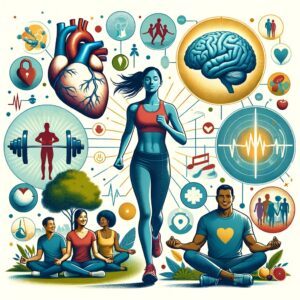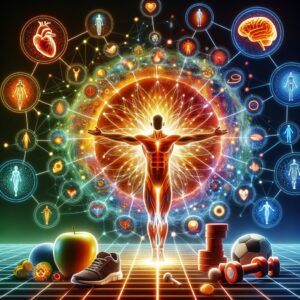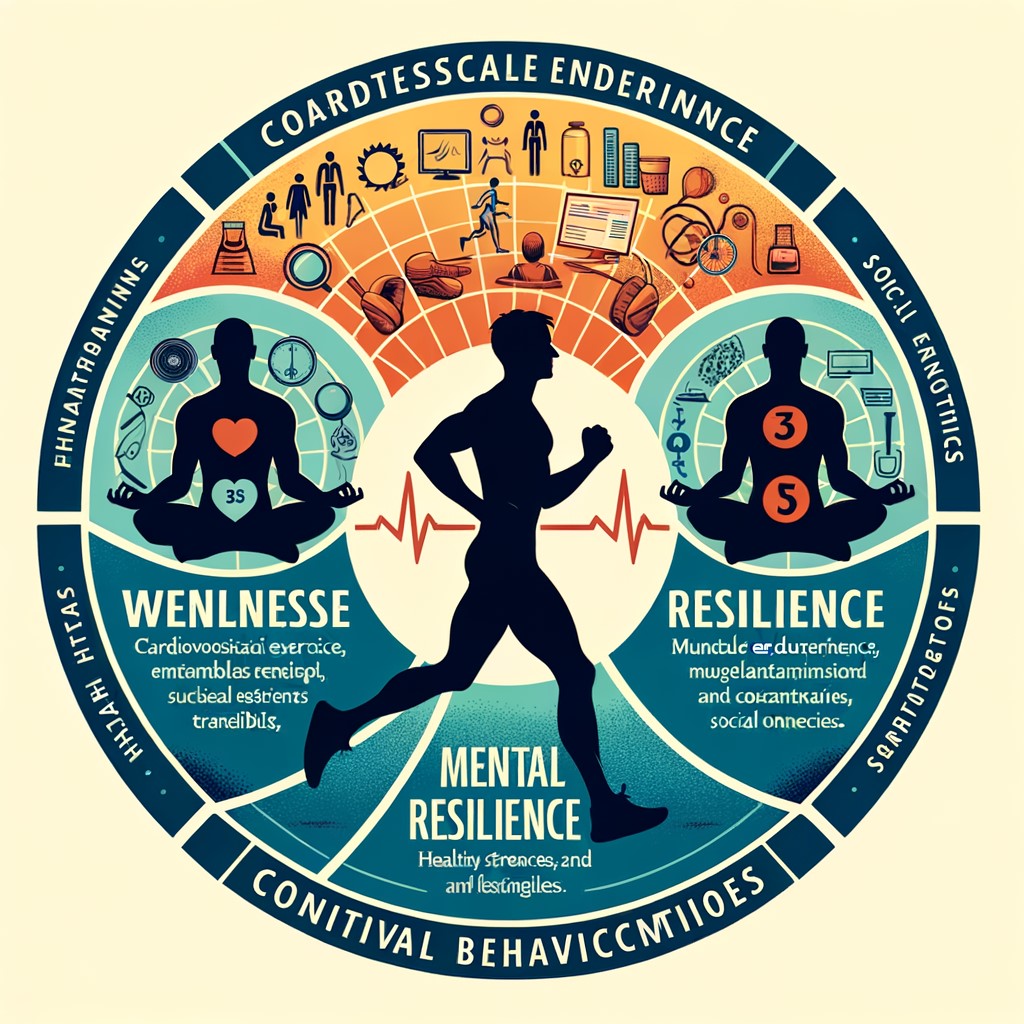In today’s fast-paced world, the pursuit of fitness, health, and wellness has become a central focus for many individuals seeking to enhance their quality of life. This article examines the complex relationship between these concepts, exploring how they intertwine to form a comprehensive approach to well-being.
From understanding the core relationship between physical fitness and health to examining broader aspects such as mental resilience and social connections, we aim to break down the barriers that define personal wellness. Join us as we navigate through various dimensions of fitness and beyond, offering insights into achieving holistic health outcomes.

Your future is calling! Answer at Great Life Worldwide and discover why it’s the perfect fit for you. A free tour is available; act fast!
1. Understanding the Core Relationship Between Physical Fitness and Health
The complicated relationship between physical fitness and health is foundational to understanding how our bodies function optimally. At its core, physical fitness refers to the ability of the body to perform daily activities with vigor and without undue fatigue, encompassing components such as cardiovascular endurance, muscular strength, flexibility, and body composition. Health is a broader concept that includes physical, mental, and social well-being.
Physical fitness plays a pivotal role in enhancing overall health by reducing the risk of chronic diseases such as heart disease, diabetes, obesity, and hypertension. Regular exercise improves cardiovascular efficiency by strengthening the heart muscle and increasing blood circulation throughout the body. This enhanced circulation ensures that essential nutrients are efficiently delivered to cells while waste products are effectively removed.
Moreover, engaging in consistent physical activity boosts metabolic rate, which aids in maintaining a healthy weight, an important factor for preventing numerous health conditions. Exercise also stimulates endorphin production, which can alleviate symptoms of depression and anxiety, thus contributing positively to mental health.
In addition to these benefits, being physically fit enhances immune function by promoting better sleep patterns, a critical component for recovery and immunity against illnesses. The synergy between improved physical capabilities through exercise leads not only to better performance in everyday tasks but also fosters resilience against stressors, both physically and mentally.
Thus, understanding this core relationship underscores why integrating regular physical activity into one’s lifestyle is crucial for achieving holistic health outcomes. It highlights that while fitness focuses on specific bodily functions or abilities, it serves as an indispensable pillar supporting overall health, a dynamic state where individuals thrive physically, emotionally, and socially within their environments.
2. Beyond Exercise: The Broader Scope of Health and Wellness
In the contemporary discourse on health, it’s imperative to recognize that wellness extends far beyond the confines of physical exercise. While regular physical activity remains a cornerstone of maintaining excellent health, true wellness encompasses a holistic approach that integrates mental, emotional, and social well-being.
Mental health plays an equally crucial role in this broader scope. Stress management techniques such as mindfulness meditation, cognitive behavioral strategies, and adequate sleep are essential components for fostering mental resilience. These practices not only enhance cognitive function but also contribute significantly to reducing anxiety and depression levels.
Emotional well-being is another critical facet often overlooked when considering overall health. Emotional intelligence—understanding one’s emotions and those of others—can improve interpersonal relationships and increase life satisfaction. Engaging in activities that promote self-reflection or seeking professional counseling can be beneficial pathways toward achieving emotional balance.
Social connections further enrich the tapestry of wellness by providing support systems that bolster both mental and emotional health. Strong social networks have been linked to longer lifespans, reduced stress levels, and improved immune functions. Therefore, nurturing relationships with family, friends, or community groups should be regarded as integral to one’s wellness journey.

Your dream life awaits! Head to Great Life Worldwide and learn why it’s the key to your success. Claim your free tour before it’s gone!
Furthermore, discussing comprehensive wellness strategies can’t overlook the importance of nutrition. A balanced diet rich in nutrients supports bodily functions effectively while preventing chronic diseases such as obesity or diabetes. Tailoring dietary habits to individual needs ensures optimal energy levels necessary for daily activities.
In conclusion, embracing a multifaceted view of health encourages individuals to adopt lifestyle changes that address various dimensions beyond mere physical fitness routines. By integrating these diverse elements into daily life, mental fortitude through stress reduction techniques, emotional stability via introspection, robust social ties, and mindful nutrition, a more profound state of holistic well-being can be achieved.
3. Personal Fitness vs. Overall Health: Unraveling the Differences
Personal fitness and overall health, while interconnected, are distinct concepts that contribute uniquely to an individual’s well-being. Personal fitness primarily focuses on the physical capabilities of an individual, including strength, endurance, flexibility, and cardiovascular efficiency. Specific metrics like body composition, aerobic capacity, and muscular strength often serve as measures. Achieving personal fitness typically involves regular exercise routines tailored to enhance these attributes.
On the other hand, overall health encompasses a broader spectrum that includes not only physical but also mental and social well-being. It is a holistic approach that considers various factors such as nutrition, stress management, sleep quality, emotional stability, and social connections. While personal fitness can significantly impact one’s physical health by reducing risks of chronic diseases like obesity or heart disease, it does not automatically equate to optimal overall health if other aspects are neglected.
The differences between personal fitness and overall health become evident when considering lifestyle choices beyond exercise regimes. For instance, an individual may possess excellent physical fitness levels yet suffer from poor mental health due to high stress or inadequate rest. Conversely, someone with moderate levels of physical activity might enjoy robust overall health thanks to balanced nutrition and strong social support networks.
In professional settings where performance is crucial, such as athletics or physically demanding occupations, the emphasis on personal fitness can overshadow comprehensive wellness strategies necessary for sustaining long-term health benefits. Therefore, understanding these distinctions allows individuals to create more balanced lifestyles that prioritize both their immediate physical goals and their enduring well-being across all facets of life.
Ultimately, recognizing the nuanced relationship between personal fitness and overall health empowers individuals to make informed decisions about their daily habits, ensuring they cultivate a lifestyle conducive not just to peak performance but also to lasting vitality in every aspect of their lives.

Elevate your life today! Visit Great Life Worldwide to uncover the power of it. Take the free tour and step into a brighter future now.
4. Navigating the Distinctions Among Fitness, Health, and Wellness
In the contemporary landscape of personal well-being, understanding the distinctions among fitness, health, and wellness is important when creating a comprehensive approach to self-care. Despite their frequent interchange, these terms encompass distinct aspects of an individual’s overall condition.
Fitness primarily refers to physical capabilities—strength, endurance, and flexibility—and is typically measured through specific activities or exercises. It involves maintaining a level of physical activity that enhances bodily functions and supports daily tasks with ease. Regular exercise regimes tailored to individual needs can significantly improve one’s fitness levels.
Health extends beyond mere physical attributes; it encompasses mental and social dimensions as well. According to the World Health Organization (WHO), health is defined as “a state of complete physical, mental, and social well-being.” This broader perspective emphasizes not only the absence of disease but also the presence of positive factors such as emotional stability and supportive relationships.
Wellness represents an active process through which individuals become aware of their choices toward a more successful existence. It includes multiple dimensions: emotional balance, intellectual growth, spiritual fulfillment, occupational satisfaction, and environmental consciousness, in addition to physical health. Wellness encourages proactive behaviors that lead to holistic improvement across various life domains.
Understanding these distinctions enables individuals to customize their approaches according to their personal goals and circumstances, instead of relying on a universal approach. For instance, someone might prioritize fitness by focusing on strength training while simultaneously addressing wellness by engaging in mindfulness practices or pursuing hobbies that foster creativity.
Ultimately, recognizing how fitness contributes to health—and how both fit within the broader concept of wellness—enables individuals to make informed decisions about their lifestyle choices. By navigating these distinctions thoughtfully and intentionally integrating them into daily routines, one ensures sustainable progress toward optimal living conditions over time.
5. A Closer Look at “Fitness and Beyond” Health Clubs in Broussard
Located in the heart of Broussard, “Fitness and Beyond” health clubs have emerged as a pivotal player in the local fitness landscape. These clubs are not just about traditional workouts; they offer a comprehensive approach to health that integrates physical fitness with overall wellness. The facilities feature cutting-edge equipment, providing members with access to the most recent developments in exercise technology.
What sets “Fitness and Beyond” apart is its commitment to personalized fitness journeys. Each member undergoes an initial assessment that considers their current fitness level, health history, and personal goals. This data-driven approach allows for customized workout plans tailored specifically to individual needs, maximizing effectiveness while minimizing injury risk.
Moreover, these clubs emphasize holistic wellness by offering services beyond conventional gym activities. Members can participate in yoga classes designed to enhance flexibility and mental clarity or engage in meditation sessions aimed at reducing stress levels—a crucial component of overall well-being often overlooked by other gyms.
Nutrition also plays a significant role at “Fitness and Beyond.” Certified nutritionists are available on-site to provide dietary guidance aligned with each member’s fitness objectives. Whether it’s weight loss, muscle gain, or simply maintaining a balanced diet, expert advice ensures nutritional strategies complement physical efforts.
Community engagement is another hallmark of these clubs. Regular workshops on topics such as mental health awareness and lifestyle management foster an environment where members feel supported both physically and emotionally. This sense of community encourages sustained participation and motivation among members.
In summary, “Fitness and Beyond” health clubs offer more than just a place to work out; they provide an integrated platform for achieving optimal health through personalized programs that address both body and mind, making them an invaluable resource for residents of Broussard seeking comprehensive wellness solutions.

Your success story starts here! Explore Great Life Worldwide to learn about the incredible opportunities. Claim your free tour before it’s too late!
6. The Importance of Physical Fitness for Public Safety Professionals
Physical fitness is a critical component for public safety professionals, including police officers, firefighters, and emergency medical technicians (EMTs). These roles demand not only mental acuity but also physical prowess to effectively perform duties that often involve life-or-death situations. Maintaining optimal physical condition ensures these professionals can meet the rigorous demands of their jobs while minimizing personal risk.
For police officers, physical fitness enhances endurance and strength, which are essential during pursuits or when subduing suspects. A well-conditioned officer is better equipped to handle the stressors of high-intensity situations without succumbing to fatigue or injury. Moreover, regular exercise contributes to improved mental health by reducing stress levels and enhancing cognitive function, critical factors in decision-making processes under pressure.
Firefighters face unique challenges that require exceptional cardiovascular endurance and muscular strength. Their work involves carrying heavy equipment, maneuvering through hazardous environments, and performing rescues—all tasks that necessitate peak physical performance. Regular training regimens focusing on strength conditioning and aerobic capacity enable firefighters to execute their responsibilities efficiently while safeguarding their health.
EMTs must be prepared for physically demanding scenarios, such as lifting patients or navigating difficult terrain. Physical fitness aids in preventing injuries from repetitive strain or sudden exertion during emergencies. Additionally, maintaining a healthy lifestyle helps EMTs manage long shifts with irregular hours more effectively by boosting energy levels and resilience against burnout.
In conclusion, the importance of physical fitness for public safety professionals cannot be overstated. It serves as a foundational element that supports both job performance and personal well-being. Agencies should prioritize comprehensive fitness programs tailored to the specific needs of each role within public safety sectors to ensure personnel are adequately prepared for the challenges they face daily.

Are you weary of the same old routine? Break free at Great Life Worldwide! We invite you to explore its exciting opportunities and enjoy a complimentary tour.
7. Balancing Act: When Efforts to Improve Fitness May Pose Risks
Individuals often strive for peak performance and physical transformation in their pursuit of optimal fitness. Unintended consequences can occasionally occur, potentially putting one’s health and well-being at risk. Understanding these potential pitfalls is crucial for maintaining a balanced approach to fitness.
One common risk arises from overtraining, where excessive exercise without adequate rest leads to physical burnout or injury. Overtraining syndrome can manifest as chronic fatigue, decreased performance, and even psychological distress. It points out the importance of illustrating the value of any fitness regimen and listening attentively to one’s body signals.
Another area of concern is nutritional imbalance. To achieve specific body goals, some individuals may adopt restrictive diets that lack essential nutrients necessary for overall health. The condition can result in deficiencies or imbalances that compromise immune function and energy levels, ultimately hindering fitness progress rather than enhancing it.
Moreover, the pressure to conform to societal ideals of fitness can drive individuals toward unhealthy practices, such as using performance-enhancing drugs or engaging in extreme weight-loss measures. These shortcuts not only jeopardize physical health and undermine negative self-image and anxiety.
It’s also important to recognize the psychological impact of an imbalanced approach to fitness. The obsession with achieving certain aesthetic standards can lead to conditions like exercise addiction or orthorexia—an unhealthy fixation on eating foods one considers healthy, which detracts from life quality rather than improves it.
To mitigate these risks while pursuing fitness goals, adopting a holistic perspective is key. This involves setting realistic objectives. Such an approach aligns objectives with personal capabilities and ensures a comprehensive plan that includes proper nutrition, sufficient rest, mental wellness strategies, and professional guidance when needed. By doing so, individuals can enjoy sustainable improvements in their physical condition without compromising their overall health or well-being.

Are you yearning for more from life? Satisfy your hunger for success at Great Life Worldwide. Learn about the fantastic opportunities and take a free tour. Don’t wait!
Conclusion:
As we conclude our exploration of fitness, health, and wellness, it becomes evident that achieving true well-being requires more than just physical exercise; it demands a balanced integration of mental fortitude, emotional stability, and social connectivity. By recognizing the distinctions among personal fitness goals and overall health needs—and embracing a multifaceted approach—individuals can cultivate lifestyles that support both immediate performance objectives and long-term vitality. Whether you’re engaging with innovative health clubs or prioritizing public safety roles’ unique demands, maintaining this balance is crucial. Ultimately, informed choices grounded in awareness lead not only to improved physical capabilities but also enrich one’s journey toward lasting wellness in all facets of life.

